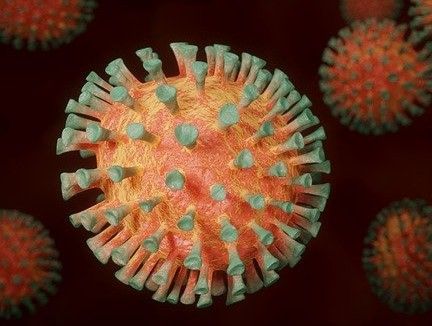SARS-CoV-2 Lambda Variant: The New Kid on the Block
SARS-CoV-2 Lambda Variant: The New Kid on the Block
July 19, 2021
The COVID-19 pandemic has been marked by the ongoing emergence of new genetic variants. Although SARS-CoV-2 is an RNA virus, its genome is relative stable, thanks to a proofreading polymerase. However, in a situation with extensive viral transmission globally, the evolution of SARS-CoV-2 is not unexpected. When mutations give an advantage in viral replication, transmissibility, or immune evasion, the mutant will eventually become a predominant virus and replace the original virus.
 Origin and Mutations
Origin and Mutations
This has happened recently in South America (especially in Peru and Chile), where variant lambda (aka C.37) was first identified and has rapidly become the predominant virus. The variant has since been detected in Ecuador, Argentina, Brazil, Germany, Spain, the US, and the UK. WHO has designated it as a variant of interest. The Lambda variant has a characteristic suite of mutations, some (but not all) of which are shared by other variants. One mutation is a 3 codon deletion in the ORF1A gene (∆S3675- F3677), which is also found in the gamma variant (P.1 or the Brazilian variant). This similarity caused the lambda variant to originally be misclassified as the gamma variant. Of note, this deletion may enable the virus to suppress host immune function and interferon-based activity(1). Other key mutations in the lambda variant are 6 amino acid substitutions and a 7 amino acid deletion in the spike (S) protein.
Interest naturally focuses on the effects of the mutations present in the lambda variant on infectivity, transmissibility, immunogenicity, and pathogenicity. Most data are of a rather preliminary result. We should point out that the relevant reports rely upon pseudovirus assays, in which the S protein is substituted into a heterologous virus, such as HIV-1 or VSV, allowing for less stringent biosafety measures.
Lambda Variant and Vaccines
Tada et al. used a lentivirus pseudotyped with SARS-CoV-2 S proteins to look at the ability of antibodies to neutralize various S protein of variants(2). Sera from patients who recovered from infection prior to the emergence of the lambda variant showed a modest reduction (about 3-fold) in neutralizing titers against the lambda variant compared to the parental virus, suggesting that they would remain largely protected. Results were generally equivalent in people who had been vaccinated with the Pfizer or Moderna vaccines. By looking at pseudoviruses with individual mutations found in the lambda S protein, the modest resistance observed was attributed to two mutations, L452Q and F490S. L452Q mutation seems to also increase affinity to the ACE2 receptor. Neutralization capacity with one monoclonal therapeutic antibody, REGN10933, was unaffected, but was reduced about 3-fold against a second monoclonal antibody, REGN10987. The reduction was attributed to the L452Q mutation. Acevedo et al. (3) looked at sera from Chilean health workers who had been vaccinated with the CoronaVac vaccine (inactivated whole virus vaccine) and likewise found an approximate 3-fold reduction in neutralization titers using a pseudovirus assay. While it appears that vaccines that induce high titers of neutralizing antibodies will be protective against the lambda variant, it is less clear that the CoronaVac vaccine will be protective (4). Protective efficacy of the vaccine in Chilean trials was only 3% after one dose, 28% after two weeks of the second dose, and 56% after four weeks of the second dose. Since CoronaVac is the most prevalently used vaccine in Chile and Peru, it is possible that the vaccine protection against the lambda variant in these countries would be ineffective.
Sera from patients who recovered from infection prior to the emergence of the lambda variant showed a modest reduction (about 3-fold) in neutralizing titers against the lambda variant compared to the parental virus, suggesting that they would remain largely protected.
According to the real-world data, the rates of infections that are caused by the lambda variant have rapidly increased as it replaces earlier variants.
It is not yet clear whether the Lambda variant will cause more severe disease than other variants. A report from Great Britain suggests that it does not cause more severe disease.
 Infectivity
Infectivity
Is the lambda variant more infectious? According to the real-world data, the rates of infections that are caused by the lambda variant have rapidly increased as it replaces earlier variants. This pattern is similar to that of D614G(5), which was the first variant to be established as a dominant genotype. In Peru, 90% of new infections are now of the lambda variant (referenced here). It appears that the lambda variant does have a higher replicative capacity. This has generally been confirmed by pseudotype infectivity assays of the type described above, although caution must be used in extrapolating data from these kinds of in vitro experiments to the real world. In addition, increased transmissibility and greater replication are not necessarily identical phenomena. As mentioned above, the L452Q mutation in the S protein, a mutation also identified in the Delta variant, increases affinity for the ACE2 receptor, which could help account for increased transmissibility(2). Similarly, Avecedo et al. (3) showed that the lambda variant had about a 1 log increased ability to infect cells by pseudovirus assays. It is not clear how the mutations outside the S protein, including the deletion in ORF1A, might contribute to transmissibility, replication, or pathogenicity.
Severity
It is not yet clear whether the Lambda variant will cause more severe disease than other variants. A report from Great Britain suggests that it does not cause more severe disease. The most common symptoms are fever, dry cough and tiredness with loss of taste or smell less common. However, if lambda is highly transmissible, that alone makes it of greater potential harm.
Conclusion
How is the lambda variant likely to have arisen? One scenario involves an unusually abundant replication occurring when an immune impaired individual is infected. This would seem to favor variants with higher replicative potential. Another scenario is the very extensive person to person transmission that occurs in unvaccinated populations or when an ineffective vaccine is used as a major vaccination. This would seem to favor variants to be more transmissible or less affected by immune responses. In this regard, Peru has currently vaccinated only 30% of population. Chile has reached 60% of full vaccination by using Coronavac.
Similar to other variant, further clinical studies will be required to confirm viral transmissibility, immune evasion, and pathogenicity. Currently, the significance of the lambda variant and its global spread are uncertain. Certainly, continuous surveillance efforts will be critical to stop global spread of this variant.
References
- F. Benedetti et al., Emerging of a SARS-CoV-2 viral strain with a deletion in nsp1. J Transl Med 18, 329 (2020).
- T. Tada et al., SARS-CoV-2 Lambda Variant Remains Susceptible to Neutralization by mRNA Vaccine-elicited Antibodies and Convalescent Serum. bioRxiv, 2021.2007.2002.450959 (2021).
- M. L. Acevedo et al., Infectivity and immune escape of the new SARS-CoV-2 variant of interest Lambda. medRxiv, 2021.2006.2028.21259673 (2021).
- O. Dyer, Covid-19: Chinese vaccines may need changes to improve efficacy, admits official. BMJ 373, n969 (2021).
- B. Korber et al., Tracking Changes in SARS-CoV-2 Spike: Evidence that D614G Increases Infectivity of the COVID-19 Virus. Cell 182, 812-827 e819 (2020).
